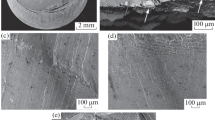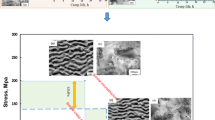Abstract
Tensile fracture behavior of a single crystal nickel-based superalloy under different orientations and temperatures was studied. The tensile fracture surfaces were analyzed by scanning electron microscope. The results showed that, generally, this single crystal nickel-based superalloy exhibited obvious tensile anisotropy. Under the condition of room temperature, the different areas of crack nucleation, propagation and final fracture area were clearly observed and varied greatly in different orientations. The fracture surface presented mixed characteristics of holes and dimples at high temperature and its fracture was dominated by micro-void coalescence.
Access this chapter
Tax calculation will be finalised at checkout
Purchases are for personal use only
Preview
Unable to display preview. Download preview PDF.
Similar content being viewed by others
References
G. L. Erickson, “The Development and Application of CMSX-10,” Superalloys ed. R. D. Kissinger, D. J. Deye, D. L. Anton, et al., (Warrendale, PA: TMS 1996), 35–44.
P. Caron, T. Khan, “Evolution of Ni-based Superalloys for Single Crystal Gas Turbine Blade Applications,” Aerospace Science and Technology 3 (1999), 513–523.
M. Marchinonni, D. Goldschidt, M. Makdini, “High Temperature Mechanical Properties of CMSX-4+Yttrium Single Crystal Nickel-base Superalloy”. Superalloy, ed. S.D. Aantolovich, R.W. Stusrud, R. A. Mackay, et al, (Pennsylvania: TMS, 1992), 775–784.
B. SETH, “Superalloys the Utility Gas Turbine Perspective,” Superalloys, ed. T. M. Pollock, R. D. Kissnger, R. R. Bowman, et al., (Warrendale, PA: TMS, 2000), 3–16.
F. Ebrahimi, J. Yanevich, and D.P. Deluca, “Development and Fracture of the PWA 1472 Superalloy Single Crystal,” Acta Mater, 48 (2000) 469–479.
W. W. Illigan, S. D. Antolovich, “Yielding and deformation Behavior of the Single Crystal Superalloy PWA 1480,” Metal Trans A, 1 (18) (1987), 85–95.
W. S. Walston, K. O’Hara, E. W. Ross, et al, “Rene’ N6: Third Generation Single Crystal Superalloy,” Superalloys 1996 ed. R. D. Kissinger, D. J. Deye, D. L. Anton et al, (Warrendale, PA: TMS, 1996), 27–34.
Z. Q. Hu, L. R. Liu, T. Jin, et al., “Development of Ni-based Single Crystal Superalloy,” Aeroengine, 3 (31) (2005), 1–7.
W. W. Milligan, S. D. Antolovich, “Deformation Modeling and Constitutive Modeling for Anisotropic Superalloys”, (Report 4215, NASA, Lewis Research Cent, Cleveland, OH, 1989).
Hidenari Takagi, Masami Fujiwara and Koji Kakehi, “Measuring Young’s Modulus of Ni-based Superalloy Single Crystals at Elevated Temperatures through Microindentation,” Materials Science and Engineering A, 387–389 (2004), 348–351.
A. Itz, U. Lagerpusch, E. Nembach, “CRSS Anisotropy and Tension/Compression Asymmetry of a Commercial Superalloy,” Acta Mater, 13 (46) (1998), 4769–4779.
K. Kakehi, “Effect of Plastic Anisotropy on Tensile Strength of Single Crystals of an Ni-based Superalloy.,” Scripta Mater, 42 (2000), 197–202.
J.L. Liu, T. Jin, J. H. Zhang, et al., “Tensile Properties and Deformation Feature of a Ni-base Single Crystal Superalloy,”(Paper presented at the Proceeding of 11th Superalloy Conference of Shanghai, China. 2007), 458–462.
William F. Smith, Javad Hashemi, Foundations of Materials Science and Engineering, (China Machine Press, 2011), 242–247.
J.V. Pellegrino, R. F. McCArney, Analysis of failures Asociated with Intergranular Fracture. Mecholsky, Powell ed., Fractography of Ceramic and Metal Failures, (1984)
Z. P. Luo, Z. T. Wu, D. J. Miller, “The Dislocation Microstructure of a Nickel-base Single-Crystal Superalloy after Tensile Fracture,” Mater Sci Eng A, 1 (354) (2003), 358–368.
Derek Hull, Fractography Observing, Measuring and Interpreting Fracture Surface Topography. (NY: Cambridge University Press, 1999), 34–36.
Author information
Authors and Affiliations
Editor information
Editors and Affiliations
Rights and permissions
Copyright information
© 2013 TMS (The Minerals, Metals & Materials Society)
About this paper
Cite this paper
Wu, D., Tian, L., Ma, C. (2013). Fracture Characteristics of a Single Crystal Nickel-Based Superalloy. In: Marquis, F. (eds) Proceedings of the 8th Pacific Rim International Congress on Advanced Materials and Processing. Springer, Cham. https://doi.org/10.1007/978-3-319-48764-9_65
Download citation
DOI: https://doi.org/10.1007/978-3-319-48764-9_65
Publisher Name: Springer, Cham
Print ISBN: 978-3-319-48586-7
Online ISBN: 978-3-319-48764-9
eBook Packages: Chemistry and Materials ScienceChemistry and Material Science (R0)




